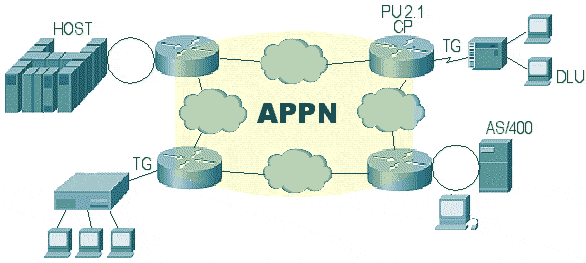What is APPN?
This article will help you in providing a good understanding of APPN networking technology concept.
What is APPN?
APPN stands for Advanced Peer-to-Peer Networking. Advanced Peer-to-Peer Networking (APPN) is a technology for interconnecting local area networks (LANs) and managing communication between them. It was developed by IBM and introduced in the late 1980s. APPN operates at the Data Link Layer (layer 2) of the OSI model, and it offers a hierarchical network architecture for efficient communication between different networks.
APPN enables peer-to-peer communication between devices on different LANs, allowing them to work together as if they were on the same network. The main intention behind designing this networking technology is to make SNA traffic flow/move simultaneously with other protocols. It uses a combination of routing and directory services to provide communication between nodes, and it supports a variety of protocols and services, including SNA, IPX/SPX, and TCP/IP.
APPN was widely used in the 1990s, but it has since been largely replaced by newer technologies, such as Internet Protocol (IP) networks and Virtual Private Networks (VPNs).

Need for APPN
The main need for Advanced Peer-to-Peer Networking (APPN) was to provide a more efficient and scalable way of interconnecting local area networks (LANs) and managing communication between them. Prior to APPN, communication between different LANs was often accomplished through complex and inefficient routing arrangements, which made it difficult to manage and maintain these networks.
APPN addressed this need by providing a hierarchical network architecture and a set of protocols and services that enabled peer-to-peer communication between devices on different LANs. This allowed organizations to create large, multi-site networks that could share resources and communicate with each other as if they were on the same network.
APPN was particularly well-suited for use in large enterprise networks, where there was a need for interconnecting multiple sites and managing communication between them. It provided a flexible and efficient way to manage communication between different LANs, and it enabled organizations to achieve economies of scale and reduce the cost of maintaining their networks.
In summary, the need for APPN arose from the desire to provide a more efficient and scalable solution for interconnecting LANs and managing communication between them, and it was particularly well-suited for use in large enterprise networks.
Working of APPN
Working of Advanced Peer-to-Peer Networking (APPN) involves a combination of routing and directory services to provide communication between nodes on different local area networks (LANs).
APPN operates at the Data Link Layer (layer 2) of the OSI model, and it uses a hierarchical network architecture to manage communication between different LANs. At the top of the hierarchy is the network coordinator, which acts as the central point of control for the network.
Each LAN in the network is represented by a node, and nodes communicate with each other using a set of routing protocols. These protocols enable the nodes to exchange information about the network topology and to find the best path for communication between different LANs.
APPN also uses a directory service, which maintains information about the resources available on each LAN and the nodes that are connected to the network. This information is used by nodes to determine the best path for communication and to find the resources they need.
When a node wants to send data to another node on a different LAN, it first sends a request to the network coordinator, which uses the information in its directory to determine the best path for communication. The network coordinator then forwards the request to the destination node, and the two nodes communicate directly with each other.
In this way, APPN enables peer-to-peer communication between nodes on different LANs, allowing them to work together as if they were on the same network. This makes it easier for organizations to create large, multi-site networks and to share resources, and communicate with each other efficiently.
Advantages of Advanced Peer-to-Peer Networking (APPN):
- Scalability: APPN provides a hierarchical network architecture that allows for scalability as the number of nodes and LANs in the network grows.
- Efficient communication: APPN enables peer-to-peer communication between nodes on different LANs, making it easier for organizations to share resources and communicate with each other.
- Resource sharing: The directory service in APPN makes it easier for nodes to find and access resources on other LANs, reducing the overhead of managing resource sharing in a large network.
- Reliability: The use of routing protocols and the hierarchical network architecture in APPN makes it more reliable and less susceptible to network failure than other network architectures.
Disadvantages of Advanced Peer-to-Peer Networking (APPN):
- Complexity: APPN can be complex to set up and manage, particularly in large networks, due to the number of protocols and services that are involved.
- Cost: APPN can be expensive to implement and maintain, especially in large networks, due to the need for specialized hardware and software.
- Limited support: APPN is a legacy technology that has been largely replaced by newer technologies, and as a result, it may be difficult to find support and resources for it.
- Limited compatibility: APPN was designed for use with specific types of networks and protocols, and it may not be compatible with other types of networks or protocols.
In conclusion, APPN has some advantages, such as scalability, efficient communication, and resource sharing, but it also has some disadvantages, such as complexity, cost, limited support, and limited compatibility. Organizations considering the use of APPN should weigh these factors carefully before making a decision. Hope you understood this topic.